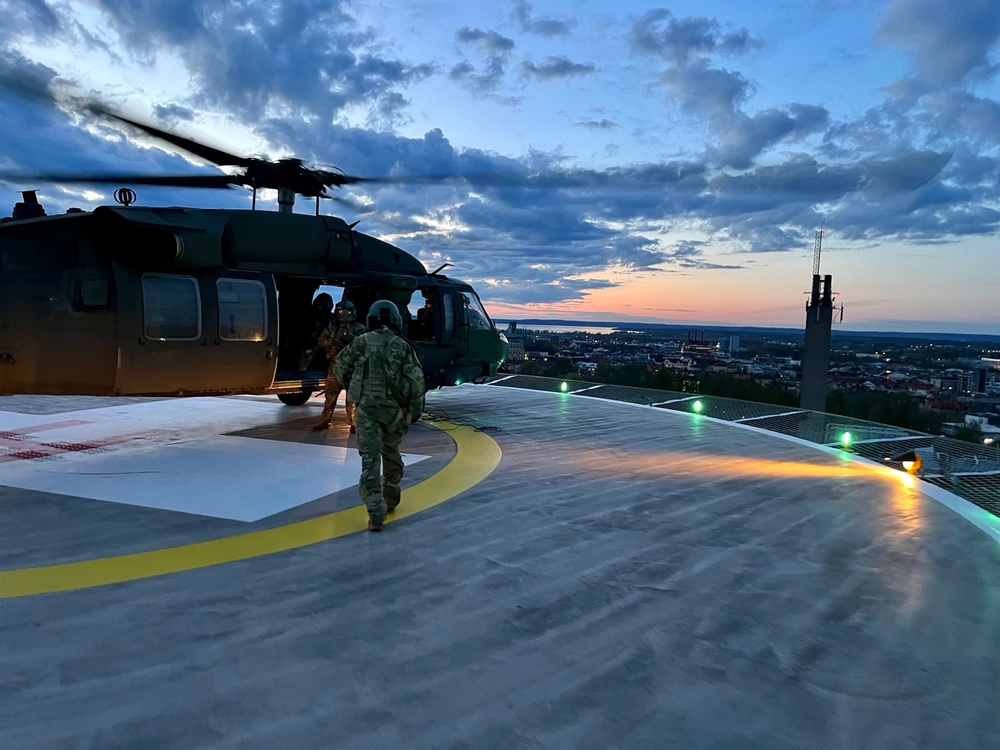In his 18 years as a rotary-wing pilot, Chief Warrant Officer 4 Mike Grego had never landed a helicopter on the helipad atop a building. Especially not in a foreign country—when a soldier really needed his help. Grego and a mixed crew of Army Reserve soldiers from across the United States responded to a call when the 173rd Airborne Brigade, along with multiple NATO allies, participated in a Joint Forcible Entry parachute jump into Hagshult Air Base, Sweden, May 7. The airborne portion kicked off Swift Response, the first NATO exercise in Sweden since its accession in March. The emergency medical flight took them from the airfield in southern Sweden to the Linköping University Hospital, a nearly one-hour distance over the forested countryside.
“It was everything I wanted all rolled into one. I didn’t want anything bad to happen to someone, but I wanted to have the opportunity to do what I do and help out. I was the last-of-last options. Once they ran the numbers and realized they could have an overwhelming amount of MEDEVAC lifts just based off a previous jump, there could be the need for a CASEVAC operation. I was nervous for sure, even when I did it just in training. Any time you are called in a MEDEVAC, you have to take a couple of breaths and slow down,” said Grego, who serves as the standardization pilot for 8-229th Assault Helicopter Battalion, based out of Fort Knox, Ky.
Prior to 173rd’s drop into Sweden, the Golf Company, 5-159th General Support Aviation Battalion MEDEVAC pilots and crew of “Task Force Tiger,” a combination of Army Reserve Aviation Command units under the command of Lt. Col. Stephen Morrow, had scouted the flight routes and performed landings at the hospital helipads in Linköping and Jönköping, two major cities within flight distance of the drop zone. Grego, however, did not get the opportunity to fly that mission. The next day, Task Force Tigers’ key leaders briefed plans and contingencies with 11th Airborne, 173rd, and NATO allies from Hungary, Italy and Spain. The main plan: Task Force Tiger would have four HH-60 MEDEVAC Black Hawks on hand to transport as many Soldiers as they could fit into their aircraft. The contingency: ground transportation and Grego’s crew.

“That’s how we train in the Army Reserve and for combat. We are here supporting our allies, coming from all across the country to work together. We hold ourselves to the standard; And Chief Warrant Officer 4 Grego demonstrates the true professionalism and dedication of our Soldiers in the Army Reserve—always prepared, always ready. I’ve got a lot of experience landing in a lot of places, I knew what to expect. Landing to a pinnacle is essentially the same thing, whether it is landing atop a mountain or to the top of a building,” said Morrow.
MEDEVAC—a military acronym for “Medical Evacuation”—is the movement of injured personnel using transportation and personnel specified for medical needs. An ambulance, for example, has medical supplies and emergency technicians for sustaining a patient en route to a center with a higher level of medical care. CASEVAC—or “Casualty Evacuation”—is the use of a non-medical transport for someone injured and does not always require a medical professional on board. While Grego has had experience as a MEDEVAC pilot in the past, having once served with 7-158th GSAB in Los Alamitos, Calif., his UH-60L was not retrofitted with the monitors, stretchers and all medical capabilities of the other HH-60 models. And he had not fulfilled the role of a MEDEVAC pilot in years. During 173rd’s jump, his ears perked when a radio call informed the Tactical Operations Center that one of the four MEDEVAC helicopters had issues early in its take-off procedures and would need to remain at the airfield.
It was his crew’s turn to move fast.
The eclectic team of professionals came from all ends of the United States. ARAC’s Maj. Mark Oherrick, Flight Nurse Practitioner, and 8-229th co-pilot Chief Warrant Officer 2 Rashaun Carter came from Fort Knox. The crew chiefs Sgt. Skylar Ashley and Spc. Abdiel Rodgriguez-Gonzalez, are from Alpha Company, 2-135th GSAB out of Joint Base Lewis-McChord, Wash. Meanwhile, Sgt. Kira Shoemaker, a critical care flight paramedic from Golf Company, 5-159th GSAB drills out of MacDill AFB, Fla. Grego did all the research he could—studying satellite imagery, approaches to the helipads and remembering his training as a pilot. When the crew landed and medical personnel stepped off to assist, Grego and his co-pilot were able to snap a selfie on the rooftop, just as the sun began to set late over the northern European backdrop. The skies began to turn a vibrant violet, burning red at the edges of the clouds floating above the cityscape.
















